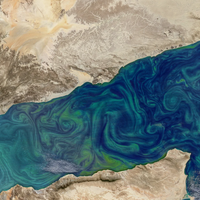Plankton are the superstars of the ocean and MAPMAKER is the tool that follows them
Without marine plankton our planet would be a different place. Future projections and impact metrics of plankton diversity around the world are now able to be seen graphically through the MAPMAKER tool. MAPMAKER's new visualisation tools allow data-driven decision-making on marine biodiversity conservation, enabling policy to be squarely resting on a science platform.
The importance of global marine biodiversity and policy to protect it
The IUCN Global Marine and Polar Programme (GMPP) has published a new multimedia story to highlight the importance of marine plankton on Earth, via the immense ecosystem services they provide, and to introduce the MAPMAKER tool which presents the data visually, thereby enabling science to be translated to policy.
 Photo: Phytoplankton Bloom Arabian Sea - UPI / Alamy Stock Photo
Photo: Phytoplankton Bloom Arabian Sea - UPI / Alamy Stock Photo
o Plankton help regulate the Earth’s climate;
o Plankton form the basis of marine food webs by providing the initial energy supply for all components of the ecosystem;
o Plankton are sensitive to environmental changes, such as climate change and marine pollution.
Global marine biodiversity supplies essential ecosystem services to human societies. To protect these ecosystem services, and our planet's nature, information on the impact of climate-caused biodiversity loss needs to be produced and taken into account in international agreements and policy documents.
What the tool allows us to do
This interactive tool is now online and freely accessible. It allows visualisation of patterns of changes between 2012-2100 according to different climate scenarios such as the ‘business-as-usual’ scenario and the ‘Meeting the Paris Agreement goals’ scenario.
MAPMAKER's visualisation of global plankton diversity patterns uses existing plankton species observations and models to tackle the lack of information on global plankton biodiversity changes. It is based on observational data and state-of-the-art statistical modelling.
Thus, this knowledge can be used to define ocean biomes, project future changes in global plankton biodiversity, and identify hotspots of change.
These projections can be translated into quantitative global impact metrics targeted at policy makers, and characterise the ecosystem impact as a function of future carbon emissions and global warming.
In this way, the new tool aims to bridge the knowledge gap and enable data-driven decision-making on marine biodiversity protection at the international policy level. It will also catalyse knowledge transfer across the science-policy-society interface.
The new partnership behind MAPMAKER development
The IUCN GMPP collaborated with the ETH Zürich Environmental Physics research group (UP) in 2020-2021 to develop a visualisation tool for policy-makers on marine plankton diversity changes MArine Plankton diversity bioindicator scenarios for policy MAKERs - the MAPMAKER project. All done with the support of the Geneva Science-Policy Interface (GSPI)
GSPI offers an independent neutral platform that strives to enhance scientific engagement with global governance actors within the Geneva region. This collaboration marks the start of a partnership on a key ocean and climate issue between IUCN and ETH Zürich, one of the world’s highest-level science organisations based in Switzerland.
Scientific partner: ETH Zürich Environmental Physics research group (UP)
Donor: Geneva Science-Policy Interface (GSPI)






